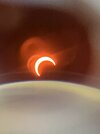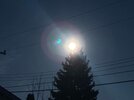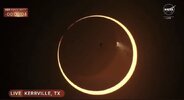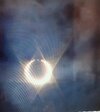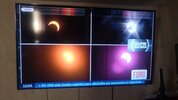Neptune at opposition in 2023
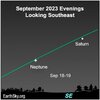
When and where to watch in 2023: Neptune emerged in the east before sunrise by April 2023 and was visible in good binoculars or a telescope in the morning sky through August. By the time of its September 19 opposition, Neptune is rising in the east at sunset and visible all night. For the rest of 2023, Neptune is up in the evening. It remains visible in good binoculars or a telescope in the evening sky through February of 2024.
Opposition for Neptune will fall at 11 UTC (6 a.m. CDT) on September 19, 2022. To catch it in dark skies, many places should look overnight on September 18-19.
Constellation at opposition: Neptune is in front of the constellation Pisces the Fish.
Brightness at opposition: The 8th planet shines at magnitude +7.8.
Distance from Earth: Neptune is at its least distance from Earth for 2023, 240 light-minutes or 28.9 AU from Earth on September 19.
Through a telescope: Through a telescope, Neptune appears 2.3 arcseconds across. Neptune’s brightest moon, Triton, is visible in medium-size telescopes.
Through binoculars: Through binoculars, Neptune will appear as a star-like object if you know where to find it.
Note: Opposition marks the middle of the best time of year to see an outer planet. Neptune reaches a yearly maximum in brightness at or near opposition. From mid-July to mid-November, Neptune will be at its brightest but it won’t be visible to the unaided eye. Think of us on Earth, sweeping between the sun and Neptune in our smaller, faster orbit. Around the same time as Neptune reaches opposition, it is also making its closest approach to Earth.

| EarthSky
What is a planet in opposition?
All the planets in the Solar System orbit around the Sun. At certain points during these orbits, the Earth finds itself directly between the Sun and another planet. This is the moment at which that planet is said to be 'in opposition'.
When Saturn is in opposition for example, Earth is between the Sun and Saturn. From our vantage point on Earth, Saturn is on the 'opposite' side of the sky to the Sun: when the Sun sets in the west, Saturn appears in the east.

What is a planet in opposition?
The best time to see and photograph a planet is when it is at opposition. Find out more and check the key opposition dates for Mars, Jupiter, Saturn, Uranus and Neptune
Neptune - astrology meaning
Neptune is called the Lord of the Invisible Empire, which is a mysterious name of a mysterious planet. Perhaps we could describe it as a dimension of life that cannot be experienced by our five senses and we can only understand and perceive it in our imagination.
How Neptune affects our lives depends very much on whether we resist its influences or we try to work with the planet of illusion and spirituality. It is common for Neptune’s influence to be a confusing one in the first portion of the transit. The ultimate “lesson” of Neptune is to help connect us to the world of the intangible. This is in stark contrast to Saturn’s transits, which re-connect us to the tangible, material world.
This can be a time of illusions and confusion, or it can be a very inspired time. Recognizing that you need more on a spiritual level can help you handle the transit more constructively. Energy levels may be low or up-and-down, and you might be more inclined towards laziness or passivity–just letting things happen without fighting back. You might miss out on opportunities because of this approach to life.
Neptune Transits | Cafe Astrology .com
Cafe Astrology offers interpretations of transiting Jupiter to the natal chart. Jupiter in aspect to natal planets.






